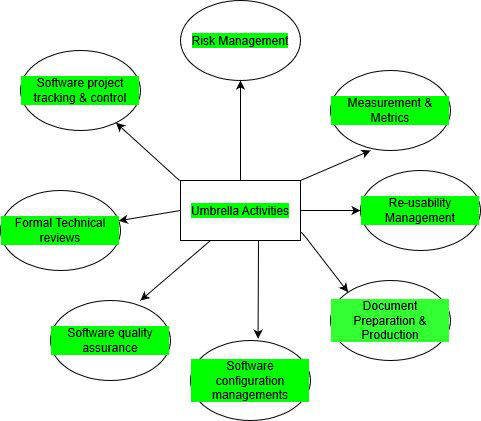Software engineering is a collection of interconnected phases. These steps are expressed or available in different ways in different software process models. Umbrella activities are a series of steps or procedures followed by a software development team to maintain the progress, quality, changes, and risks of complete development tasks. These steps of umbrella activities will evolve through the phases of the generic view of software development.
The activities in the software development process are supplemented by many general activities. Generally, common activities apply to the entire software project and help the software development team manage and track progress, quality, changes, and risks.
Umbrella activities consist of different tasks:
- Software Project Tracking and Control
- Formal Technical Reviews
- Software Quality Assurance
- SCM or Software configuration management
- Document Preparation and Production
- Re-usability Management
- Measurement and Metrics
- Risk Management
 |
Umbrella Activities
- Software project tracking and control: This activity allows the software team to check the progress of software development. Before the actual development starts, make a software development plan and develop on this basis, but after a certain period of time, it is necessary to analyze the development progress to find out what measures need to be taken. It must be accepted at an appropriate time after the completion of development, testing, etc. The test results may need to reschedule the development time.
- Risk management: Risk management is a series of steps to help software development teams understand and manage uncertainty. It is a very good idea to identify it, assess the likelihood of it happening, assess its impact, and develop an “if the problem does happen” contingency plan.
- Software quality assurance: As its name suggest this defines and conducts the activities required to ensure software quality. The quality of the software, such as user experience, performance, workload flexibility, etc., must be tested and verified after reaching the specified milestones, which reduces the tasks at the end of the development process, which must be performed by a dedicated team so that the development can continue.
- Technical reviews: It assesses software engineering work products in an effort to uncover and remove errors before they are propagated to the next activity. Software engineering is done in clusters or modules, after completing each module, it is good practice to review the completed module to find out and remove errors so their propagation to the next module can be prevented.
- Measurement: This includes all measurements of all aspects of the software project. Define and compile process, project, and product metrics to help the team deliver software that meets the needs of stakeholders; it can be used in conjunction with all other frameworks and general operations.
- Software configuration management: It manages the impact of changes throughout the software development process. Software Configuration Management (SCM) is a set of activities designed to manage changes by identifying work products that can be changed, establishing relationships between them, and defining mechanisms for managing different versions of them. Work product.
- Reusability management: Define the standards for the reuse of work products (including software components), and develop mechanisms to implement reusable components. This includes the approval of any part of a backing-up software project or any type of support provided for updates or updates in the future. Update the software according to user/current time requirements.
- Work product preparation and production: It encompasses the activities required to create work products such as models, documents, logs, forms, and lists.
|





0 Comments